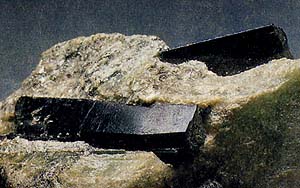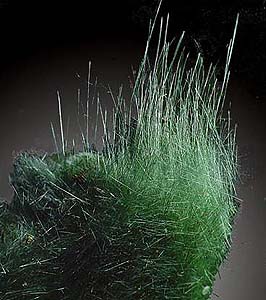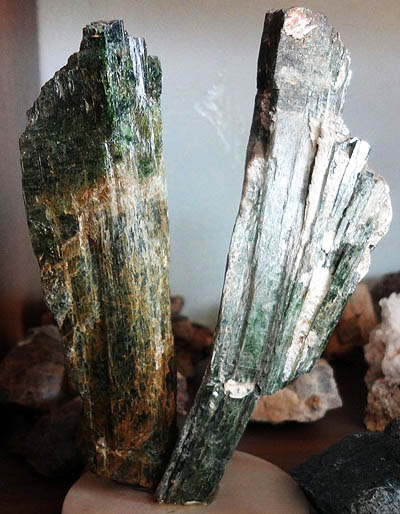Amphiboles (silicates): Actinolite
 Diagnostic card.
Diagnostic card.
On the picture. On two samples of actinolite, the prismatic shape of its crystals is clearly visible.
Ca 2 (Mg, Fe) 5 (OH, F) 2 (Si 4 O 11 ) 2
Singonia monoclinic
Hardness 5,5-6
Specific weight 2,9-3,3
Cleavage is perfect
The fracture is stiff, irregular, brittle
Green colour
Color in powder white
Gloss is glassy, silky

 It is represented by elongated prismatic crystals, as well as by columnar aggregates, sometimes fibrous; In the latter case we are dealing with amphibole-asbestos. Actinolite has a green coloration of various shades. Gloss is glassy or silky (for fibrous aggregates). Actinolite - this ornamental stone, consisting of many needle crystals and their radiant aggregates.
It is represented by elongated prismatic crystals, as well as by columnar aggregates, sometimes fibrous; In the latter case we are dealing with amphibole-asbestos. Actinolite has a green coloration of various shades. Gloss is glassy or silky (for fibrous aggregates). Actinolite - this ornamental stone, consisting of many needle crystals and their radiant aggregates.
Chemical composition. Strongly changeable; Is similar to tremolite, but enriched with iron (6-13% Fe). Varieties: nephritis (Greek "kidney" - kidney) - green, very dense (under the microscope) aggregate of minerals; Amiant (Greek "amiantos" - pure, pure) - amphibole asbestos, actinolite asbestos. Opaque; Thin crystals and fragments shine through.
Crystal structure. Double chains (belts) of tetrahedra. Class of symmetry. Prismatic - 2 / ton. Cleavage. According to the prism (110). Aggregates. Radial-gingival, fibrous, solid, coarse-grained.
Actinolite belongs to the group of amphiboles. Forms a filamentous or fused-fibred aggregates from a greyish-green to a dark green color. The hardness is 5.5-6. The density is 2.9-3.3. The gloss is glassy or more often silky. The line is white. Thin-fiber actinolite is elastic and is used as rubber filler for tires. Places of distribution: High Tauern (Carinthia, Austria), Switzerland.
Diagnostic signs.
In the flame of a candle melts, in acids it does not dissolve. It can be replaced by changes in serpentine, but rarely. Behavior in acids. Difficultly soluble. Bottled green, light green to dark green color.
Origin.
Actinolite - a mineral quite common in nature. It occurs relatively often in crystalline schists, and also (more rarely) in igneous rocks of the gabbro-diabase type.
 Deposits and applications.
Deposits and applications.
In Italy, this mineral is found in the form of bluish crystals in talc masses in Val-Germanask in the Piedmont region. Amphibole-asbestos is the best heat and soundproof material.
Fibrous actinolite inclusions (the so-called "hairies") create the effect of a "cat's eye" in quartz and impart a special charm to many transparent crystals. The greenish color of actinolite is due to the presence of iron compounds in this mineral. Solid thin-grained masses of emerald green actinolite are sometimes called "smaragdite" or "emerald spar".
Fine-fiber (actinolite-asbestos) and radiant aggregates of actinolite form high-decorative inclusions ("hairy") in transparent crystals of many minerals, create the effect of a feline eye in quartz. Solid fine-grained masses of emerald-green actinolite (smaragdite) are used as an ornamental stone, sputanno-fibrous dense aggregates are known as jade. In the deposits of East Africa, discoveries of transparent actinolite crystals of brown and green color, suitable for faceting, were noted.
A series of actinolite.
Includes, in addition to tremolite, ferroactinolite, which is the most iron-enriched member of the series. Under the name smaragdit, a felt-like variety of emerald green color is known. Another kind of actinolite is jade, or amphibole greed.
Nephrite - amphibole, a very popular species of actinolite, (in Greek nephros - kidney) is even more mated than jadeite. Its colors are diverse, the most valuable are green jade. Spots and streaks are common. Silicate of calcium, magnesium and iron.


Actinolite-bisolite. Photo: © Actinolite. Greiner, Zillertal, Tyrol, Austria. Photo: © А.А. Evseev.

Actinolite. Okr. Sludorudnik settlement (vein No. 170), South Ural, Russia. Photo: © А.А. Evseev.
- Ghetchellit - "New Almaden blend" - arsenide and antimony sulfide (modern sulfosol)
- Antimony is a toxic metal (semimetal) , widely used in metallurgy, medicine and engineering
- Zirconium - a rare and undiscovered metal and the most dangerous precious stone in oxide and salt
- Gold - yellow dangerous and poisonous metal of modern accurate digital and cable technologies
- Sulfur is a golden-yellow toxic substance and a sign of active volcanic activity
- Cadmium is an undisputed toxic silvery metal unknown to a wide range of people
- Lead - a poisonous gray imitator of metallic silver and toxic metal blende
- Arsenic is a classic poison of medieval and modern poisoners and medicine in medicine
Poisonous and radioactive dangerous stones and minerals
** - poisonous stones and minerals (mandatory check in the chemical laboratory + explicit indication of toxicity)
** - radioactive stones and minerals (mandatory check on the standard dosimeter + ban on open sales in case of radioactivity exceeding 24 milli / g / h + additional measures of population protection)
Catalog of minerals and semi-precious stones of the world by groups
** - poisonous stones and minerals
** - radioactive stones and minerals


Comments
When commenting on, remember that the content and tone of your message can hurt the feelings of real people, show respect and tolerance to your interlocutors even if you do not share their opinion, your behavior in the conditions of freedom of expression and anonymity provided by the Internet, changes Not only virtual, but also the real world. All comments are hidden from the index, spam is controlled.